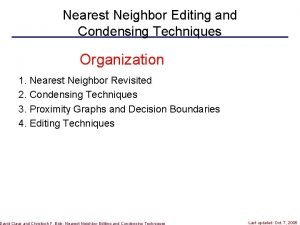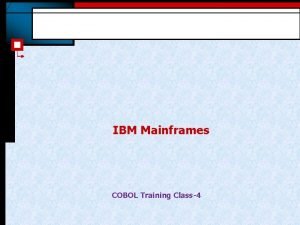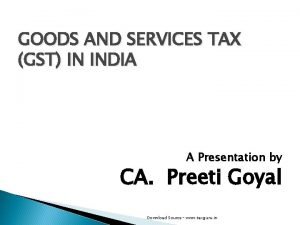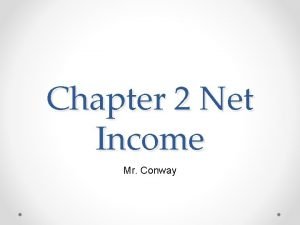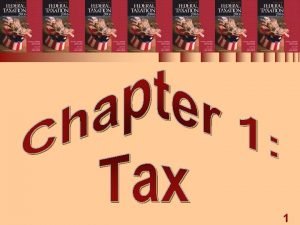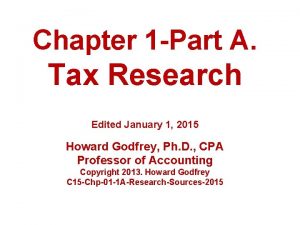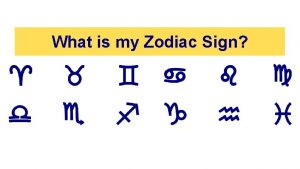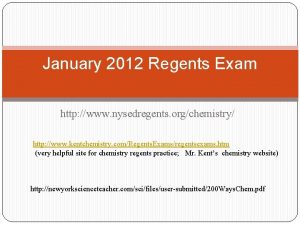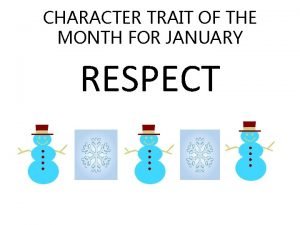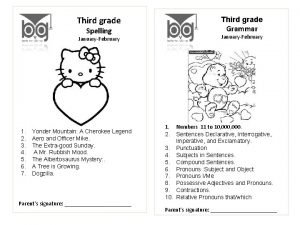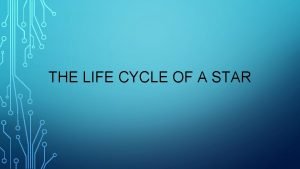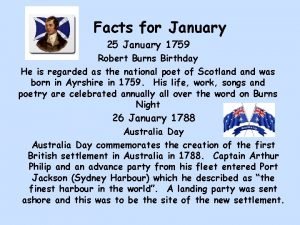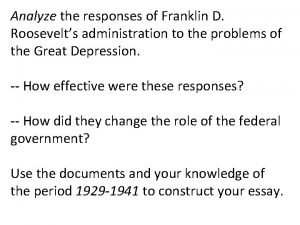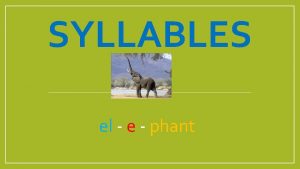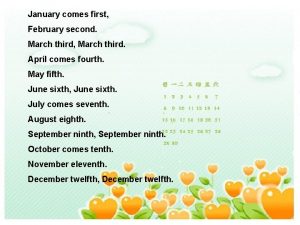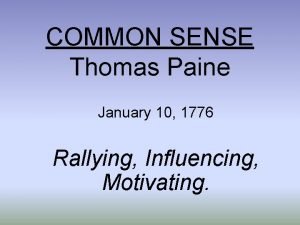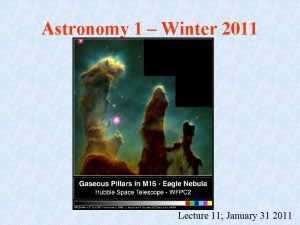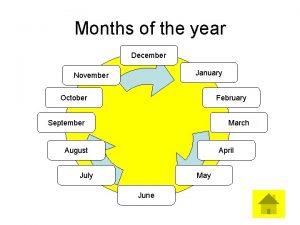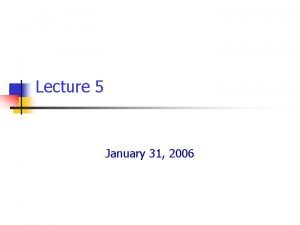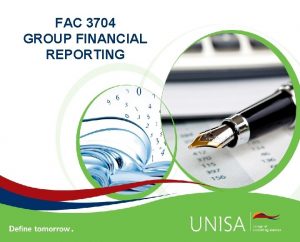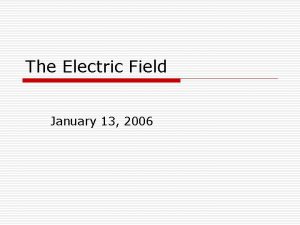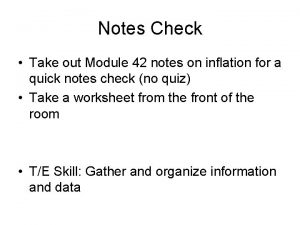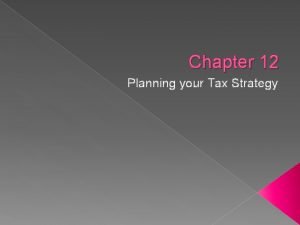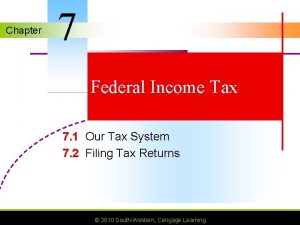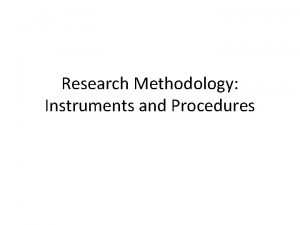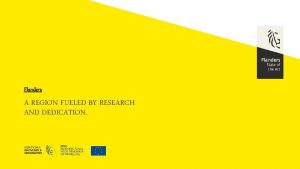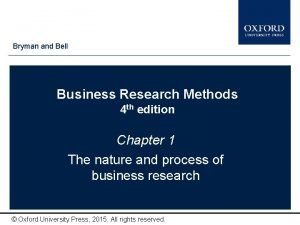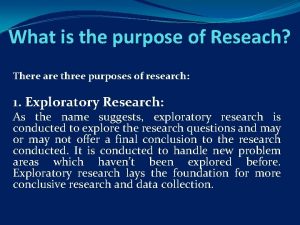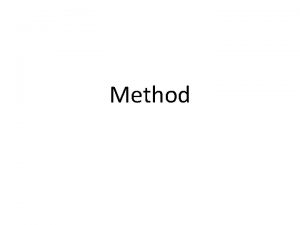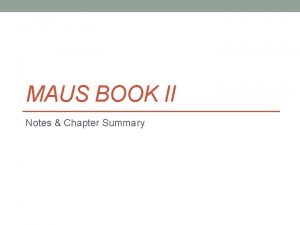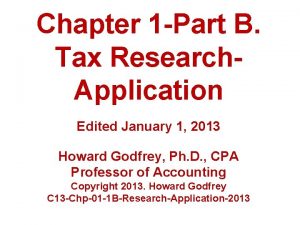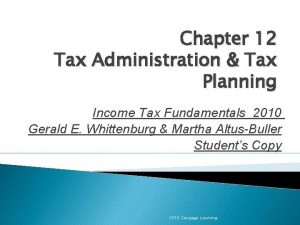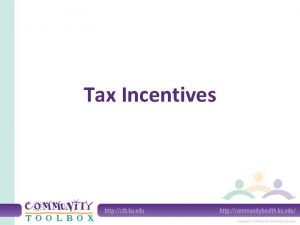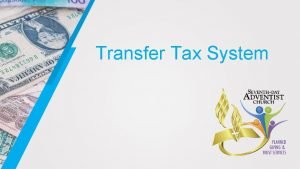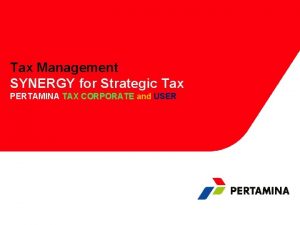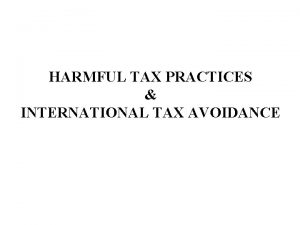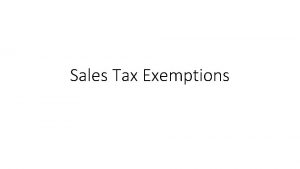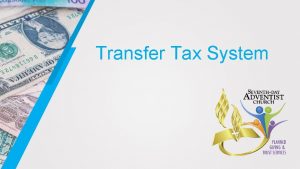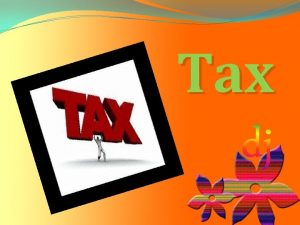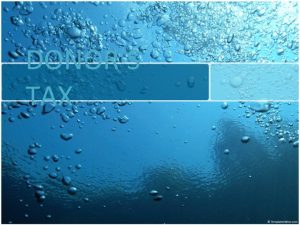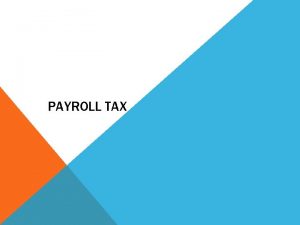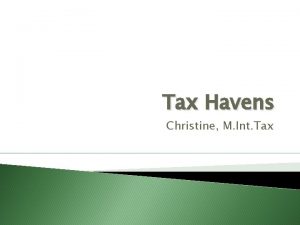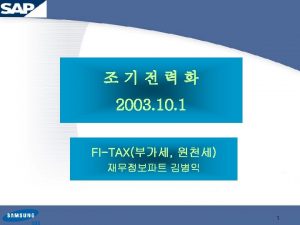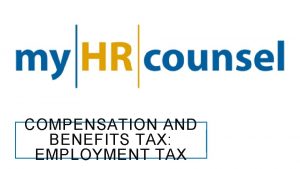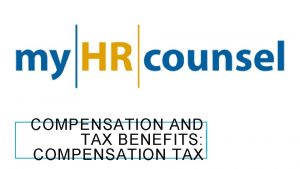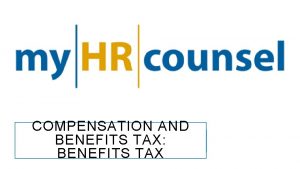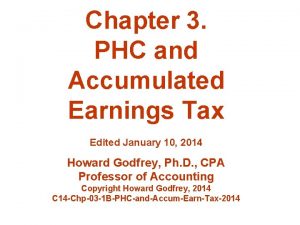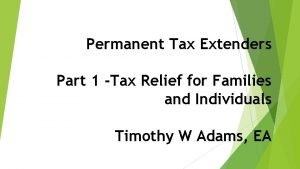Chapter 1 Part A Tax Research Edited January































































































- Slides: 95

Chapter 1 -Part A. Tax Research Edited January 1, 2015 Howard Godfrey, Ph. D. , CPA Professor of Accounting Copyright 2013. Howard Godfrey C 15 -Chp-01 -1 A-Research-Sources-2015

Chapter 1 A. Learning Objectives-1 A student should be able to: 1. Understand Reasons for tax law (control economy, social objective, Etc) 2. Describe steps in the tax research process (Know sources of tax law). 3. Explain how the facts influence the tax consequences. 4. Identify sources of tax law & understand the authoritative value of each. 5. Understand the basic citations, such as Ltr. Rul. 201031004 or 130 T. C. 88, etc.

Chapter 1 A. Learning Objectives-2 6. Consult the tax services to research an issue. 7. Use Citator to assess authorities. 8. Grasp the basics of computerized tax research. 9. Understand guidelines that CPAs in tax practice follow. 10. Prepare work papers & communications to clients.


1. Reasons for Tax Law Why are certain provisions in the tax law?

Why? Text page 1 -1. What rules are found in sections 167 and 168? What rules are found in Sec. 168(k) and 179? Why do we have the special rules identified in the code sections above?

Why? Text page 1 -5. What rules are found in section 21? Why do we have the special rules identified in the code section above?


2. Research Steps Describe steps in the tax research process. (Know sources of tax law).

Client-oriented research is conducted by accounting & law firms for their clients. It involves determining tax consequences of a certain transaction for a given client. It is performed in 1. Closed-fact or tax compliance situations. 2. Open-fact or tax-planning situations.

Steps in Research Process. Pg. 35+ Circular nature tax research. Get more facts. Restate the research question. Find more tax law. Six basic steps to the tax research process: A. Determine the facts. B. Identify the issues (questions). C. Locate the applicable authorities. D. Evaluate the authorities and choose those to follow where the authorities conflict. E. Analyze the facts in terms of the applicable authorities. F. Communicate conclusions & recommendations to client.

Keep in mind A. The objective is not to minimize taxes per se but rather to maximize the after-tax return. B. One does not engage in unilateral transactions; thus, the tax ramifications to all parties to the contract are relevant. C. Taxes are only one of the costs of doing business. D. The time for tax planning is not restricted to when one enters into an investment, contract, and other arrangement, but rather the time extends throughout the life of the activity.

Uncertainty Tax research often involves an “uncertain area; " that is, one that does not have a clearcut, unequivocally correct solution. The issue should be pursued through the use of a specifically tailored set of detailed questions. Tax research may also involve determining which issues need to be researched. It requires a fairly extensive knowledge of tax law to be able to determine which issues need to be researched.

Financial Accounting A tax advisor should always bear in mind the financial accounting implications of proposed transactions. An answer that may be desirable from a tax perspective may not always be desirable from a financial accounting perspective. Success in any tax practice, especially at managerial level, requires consideration of both sets of objectives and orientations.

Taxation – Relationships Example: Sec. 2501 Constitution Example: Sec. 170(l)



Which of the following sources is not considered to be primary authority? a. b. c. d. statutory law administrative law judicial law tax journal articles

3. Facts Explain how the facts influence the tax consequences.

Importance of the Facts. The importance of a particular set of facts to the tax results should be emphasized. See next slide.

Importance of the Facts. Richard Crepe owns 100% of the stock of Crepe Corporation, which had taxable income of $10, 000 in 2015. How much federal income tax does Crepe Corp. owe for 2015? a. $1, 500 b. $2, 500 c. $3, 400 d. $3, 500

Importance of the Facts. Richard Crepe, M. D. owns 100% of the stock of Crepe Corporation’s income and expenditures are derived from the medical services provided by Dr. Crepe. At the end of 2015 Crepe Corporation had $10, 000 in reportable taxable income. How much federal income tax was Crepe Corporation required to pay for the 2015 year? a. $1, 500 b. $2, 500 c. $3, 400 d. $3, 500 See Sec. 11(b)(1), also 11(b)(2).

4. Sources of tax law Identify sources of tax law and understand the authoritative value of each. 5. Consult tax service

The Sources of Tax Law “Tax law" generally encompasses much more than just tax statutes as enacted by Congress. The law contains very general language that requires interpretation, both administrative and judicial. Administrative interpretations include Treasury Regulations, revenue rulings and revenue procedures. Judicial interpretations consist of court decisions. Tax law also consists of committee reports issued by Congress.

Legislative Process-1 Text 1 -17+. All tax legislation must originate in the House of Representatives. Tax bills are referred to the House Ways and Means Committee. After a bill is approved by the House Ways and Means Committee, it moves to the floor of the House for consideration. If approved by a majority of the House it moves to the Senate. After consideration by the Senate Finance Committee, it moves to the Senate floor for approval. Usually the House and Senate bills will not be in complete agreement.

Legislative Process-2 The bill will then go to a conference committee consisting of members of both houses. A compromise will then be made between the two versions of the tax bill. The compromise is then voted on by both houses of Congress and goes on to the President for his signature or veto. Both houses of Congress generally hold extensive hearings at which time interested parties are allowed to testify. U. S. Government Printing Office publishes the statements made at hearings.

Legislative Process-3 Committee reports explaining Congress's purpose in drafting legislation are published by the U. S. Government Printing Office in the Cumulative Bulletin. Committee reports are particularly useful in interpreting the law prior to issuance of Treasury regulations.

Committee Reports. As a bill proceeds through Congress, committee reports are generated. What three committee reports typically are generated in this process?

Committee Reports- Page 18+ House Ways and Means Committee, Senate Finance Committee, Joint Conference Committee may generate committee reports in the process of a bill becoming law.

Committee Reports Why are Committee Reports useful to a tax researcher? See committee report posted on course website for change in FICA tax.

Committee Reports contain a general and technical discussion of a bill’s provisions. The reports contain important information about the legislative intent of a bill that may be used to resolve disputes between taxpayers and the Internal Revenue Service. These reports may provide the only guidance you have about a new law until the Treasury provides regulations.

Internal Revenue Code. The Internal Revenue Code is the foundation of all tax law. It was first codified in 1939. Recodified in 1954, it has now been named the Internal Revenue Code of 1986. Whenever the law is changed, old language is deleted and new language is added. However, a complete history is usually provided after a code section.

Internal Revenue Code • A tax bill passed by Congress is usually enacted as a revenue act that amends the existing Internal Revenue Code • Code divided into subtitles, chapters, subchapters, and sections • Citations to the Code usually are to sections (Sec. or §)

Internal Revenue Code Your client recently received a divorce from her husband. She has begun paying him alimony of $10, 000 per month. She is unable to find suitable housing, so she will continue to live with her former husband (in the house that he received in the divorce) for about six months until she can build a new house. Is the alimony deductible? Do some research from your Code & Regs book. Sec. 71.


Which of the following is true of the Internal Revenue Code? a. It includes statutes and regulations b. It is issued by the Tax Court c. It contains law passed by Congress d. It contains pronouncements of the Treasury Department e. It contains pronouncements of the Internal Revenue Service

Tax Treaties IRC 7852. The U. S. has treaties with a number of foreign countries. The treaties may pertain to tax and other matters. IRC 7852. Provisions contained in a treaty in most cases override the rules contained in the IRC.

Statutory Sources of Authority • • U. S. Constitution Internal Revenue Code Tax treaties Committee reports that indicate the legislative intent of a bill – House Ways & Means Committee – Senate Finance Committee – Joint Conference Committee

Treasury Regs-1. Page 1 -19+ Treasury Department issues Treasury Regulations as interpretations of the statute. They provide examples complete with computations to assist in understanding the statutory language. Because statutory changes occur frequently, regulations are not always updated in a timely manner. When referring to a regulation, the tax advisor should consult the introductory note in order to determine when the regulation was adopted. IRC 7805

Treasury Regulations-2 Treasury Regulations are first provided in proposed form and the public has an opportunity to comment and suggest changes. Proposed regulations have no more authoritative weight than the position the IRS argues for in a brief, but provide guidance on the Treasury Department’s interpretation of a statute.

Treasury Regulations-3 Temporary regs (which generally are effective upon publication) are often issued soon after a major statutory change to provide guidance on procedural and computational matters. Temporary regulations have the same authoritative value as final regulations; however, they cannot remain in effect for more than a three-year period. (They precede final regulations. ) Temporary regulations must be issued concurrently with proposed regulations. IRC 7805

Treasury Regulations-4 Final regulations are drafted after the public has time to comment on the proposed regulations. Final regulations have the same authoritative weight as the statute and generally take effect retroactive to the effective date of statutory language they interpret.

Treasury Regulations-5 For changes to the IRC enacted after July 29, 1996, the Treasury is generally precluded from issuing regulations with retroactive effect. In the case of final regulations, however, a regulation can be effective on the date proposed or the date on which temporary regulations are filed with the Federal Register. Regulations issued within 18 months of the date of a change to the statute can be issued with retroactive effect. See committee report for PL 104 -168. Sec. 7805

Treasury Regulations-6 Regulations may be classified as either interpretative or legislative. Interpretative regulations are issued under the general authority of Sec. 7805 and make the statutory language easier to understand apply. They provide illustrations about how to perform certain computations. Legislative regulations provide rules on highly technical matters where Congress has delegated the rulemaking to the Treasury Dept. (e. g. , consolidated tax return issues). See Sec. 1501, 1502

Treasury Regulations-7 Section 7805 provides that the Secretary of the Treasury has the right to prescribe regulations and to provide what extent they are to be applied retroactively. Occasionally, taxpayers can successfully argue that a regulation is invalid and, consequently, should not be followed. This will occur only if the courts find that the regulation is "unreasonable and plainly inconsistent with the revenue statutes. “ See Sec. 7805

Treasury Regulations-8 Some courts apply the legislative reenactment doctrine, which holds that regulations finalized many years earlier and not amended by Congress through changes to the statutory language have Congressional approval.

Treasury Regulations-9 Numbers before the decimal point indicate the general subject matter of the regulation. Numbers to the right of the decimal place refer to the IRC section being interpreted. Numbers to the right of that number indicate the number of the regulation.

Treasury Regulations-10 Temporary or proposed regulations are cited as Temp. Reg. Sec. or Prop. Reg. Sec. When providing a citation, the researcher should be as precise as possible. An example: Reg. Sec. 1. 165 -5(I), Ex. 2(I), which refers to the first portion of Example 2 that is contained in the first portion of the fifth regulation interpreting Sec. 165.

Regulations Which of the following statements about regulations is not true? a. They are issued by the Treasury Department. b. Proposed regulations have more authority than temporary regulations. c. Final regulations are issued as Treasury Decisions. d. Legislative regulations have more authority than interpretative regulations. e. A regulation’s identifying number includes the code section which it interprets.

Regulation Citations In the citation Reg. § 1. 247 -3, what do the 1 and the 247 indicate?

Regulation Citations Solution: The 1 is a prefix that refers to an income tax regulation; the 247 is a root number that designates the Code section to which the regulation is related.

Which of the following statements about regulations is not true? a. They are issued by the Treasury Department. b. Proposed regulations have more authority than temporary regs. c. Final regulations are issued as Treasury Decisions. d. Legislative regulations have more authority than interpretative regs. e. A regulation’s identifying number includes the code section which it interprets.

Administrative Rulings-1. There a number of different means that the IRS uses for interpreting the statute. After referring to the IRC and Treasury Regulations, tax advisors are likely to refer next to IRS interpretations for further authority for answering a tax question.

Revenue Rulings-1 Revenue rulings are used to indicate the tax status of a specific transaction, which has wide taxpayer interest. They represent the viewpoint of the IRS and do not have as much authority as federal court cases or regulations. Approximately one hundred rulings are issued each year.

Revenue Rulings-2 A taxpayer does not have to follow a ruling if there is sufficient authority for different treatment. An IRS agent is, however, bound by the rulings. Rulings are published weekly in the Internal Revenue Bulletin (I. R. B. ) and semiannually in the Cumulative Bulletin (C. B. ). How are revenue rulings cited?

Revenue Rulings-3 Does the Code allow a deduction for Medical Expenses? What about the cost of a drug to grow hair for a bald person? Tanning Lotion? Viagara? Tattoo? Where would you look?

Revenue Procedures -1 Revenue procedures usually deal with procedural aspects of tax practice. They are first published in the Internal Revenue Bulletin and later in the Cumulative Bulletin.

Letter Rulings -1 Letter rulings are initiated by taxpayers who ask the IRS to explain the tax consequences of a particular transaction. The IRS responds in a letter ruling that can be relied on only by the person requesting it. They provide insight into the current thinking of the IRS. CCH publishes rulings with any confidential information deleted in a separate letter ruling service. Refer now to book page 22 to illustrate how letter rulings are cited.

Tax Planning Can be Profitable- (1 of 2) U. S. Ruling Lets NCNB Earn $2. 8 Billion Before Taxes Begin Tax Shelter On Texas Deal Could save Bank $1 Billion (A brief “old” newspaper article) NCNB Corp. owes its thanks to the IRS. Its thanks, and perhaps as much as a billion dollars. That's how much the Charlotte banking company could save in federal income tax in the next few years because of a June 1988 IRS ruling, a five-page letter, that formed the bedrock of NCNB's winning bid in July 1988 for the failed First Republic Bank network in Texas.

Tax Planning Can be Profitable- (2 of 2) The tax break, from First Republic losses before NCNB took over, enabled NCNB to outfox the much larger banks that also bid for First Republic's 40 banks nearly doubled NCNB's assets to $60 billion, making it the nation's ninth-largest bank after it assumed full ownership of the Texas bank in July. Purchases of savings and loans in Texas and Florida pushed that ranking up to 7 th. (Note: This is from an old newspaper article. )

Technical Advice Memoranda (TAM) When a taxpayer's return is being audited with respect to a complicated, technical matter, the taxpayer may request that the matter be referred to the IRS National Office in Washington, D. C. concerning the appropriate tax treatment. The answer is issued in the form of a Technical Advice Memoranda, which is available in the form of a letter ruling.

Information Releases -1 Information releases contain information about interpretations of general interest and are released to the news media throughout the United States.

Announcements and Notices-1 Information releases that are more technical and aimed at tax practitioners are issued in the form of Announcements are often issued before temporary or proposed regulations can be issued. The IRS is bound by announcements and notices in the same way as if contained in a revenue ruling.

Administrative Sources of Authority Treasury Regulations Internal Revenue Service Revenue Rulings Revenue Procedures Letter Rulings & other pronouncements

Judicial Decisions -1 Judicial decisions comprise an important source of tax law. Judicial decisions in different jurisdictions are sometimes in conflict.

Judicial Sources U. S. Court of Federal Claims U. S. District Court U. S. Tax Court U. S. Court of Appeals for Federal Circuit U. S. Court of Appeals Supreme Court

Overview of Court System-1 There are three trial courts - the U. S. Tax Court, the U. S. Court of Federal Claims and the U. S. District Courts. Litigation may begin in any court, but precedent is an important factor in determining where it should begin. Court cost may be an important factor.

Overview of Court System-2 Taxes must be paid before litigation begins in the U. S. Court of Federal Claims or the U. S. District Courts. After the taxes are paid, a claim for refund is filed which will be denied by the IRS. A suit for refund is then brought and, if won, a refund with interest is obtained. A suit may be brought in the Tax Court. If lost, the deficiency plus any interest and penalties must be paid.

Overview of Court System-3 The District Courts are the only place that a jury trial is possible. Decisions can be appealed from the Tax Court and the U. S. District Courts to the Court of Appeals in the taxpayer's circuit. Appeals from the U. S. Court of Federal Claims are taken to the Court of Appeals for the Federal Circuit.

Overview of Court System-4 A party who loses at the appellate level can ask the Supreme Court for a writ of certiorari. The Supreme Court hears only about six to ten tax cases a year. (See Figure 1. 2 for a Map of the Geographical Boundaries of the Circuit Courts of Appeals. ) (See Figure 1. 1 for an overview of the court system. ) pg. 23 Don’t memorize info. in these Figures.

U. S. Tax Court. Sec. 7441, 7463. U. S. Tax Court originated in 1942 as the successor to Board of Tax Appeals. It is a court of national jurisdiction that hears only tax-related cases. All taxpayers, regardless of their state of residence, may litigate in the Tax Court. It has 19 judges, including one chief judge. The President, with the consent of the Senate, appoints the judges for a 15 -year term and may reappoint them for an additional term. The judges, specialists in tax-related matters, periodically travel to roughly one hundred cities throughout the country to hear cases. In most instances, only one judge hears a case.

Small Cases. Sec. 7463 Tax Court has special policy for cases where the amount in question does not exceed $50, 000 a year (i. e. , small cases). Taxpayers may appear without an attorney. The cases are heard by special commissioners instead of one of the Tax Court judges. Decisions under this procedure cannot be appealed.

Acquiescence policy The IRS has an acquiescence policy with regard to federal court decisions that have been decided in the taxpayer's favor. If it wishes to go on record that it agrees with a federal court decision, it acquiesces. If it wishes to disagree with a decision, it issues a nonacquiescence. An acquiescence or nonacquiescence is binding on an IRS agent. If a taxpayer is audited and has taken a position, which the IRS has issued a nonacquiescence, litigation will likely be the only recourse for the taxpayer. IRS acquiescences and nonacquiescences are published in the Internal Revenue Bulletins and Cumulative Bulletins.

Regular decisions - Tax Court Regular decisions of Tax Court are published by U. S. Government Printing Office in a bound volume known as the Tax Court of the United States Reports. Soon after a decision is made public, it is also published by RIA and CCH in their reporters of Tax Court decisions.

U. S. District Courts Each state has a U. S. district court. Some states have several district courts. Many different types of cases are heard by this court. Taxpayer may request a jury trial. District court decisions are officially reported in the Federal Supplement (F. Supp. ) published by West. Tax decisions are also published by RIA in American Federal Tax Reports (AFTR) and by CCH in U. S. Tax Cases (USTC).

U. S. Court of Federal Claims The U. S. Court of Federal Claims, as reorganized in 1982 and renamed in 1992, is a national court with decisions appealable to the Circuit Court of Appeals for the Federal Circuit. U. S. Court of Federal Claims decisions were published in the Claims Court Reporter by West Publishing Co from 1982 to 1992. These cases are now reported in the Federal Claims Reporter (Fed. Cl. ). In addition, the AFTR and USTC services report these tax decisions.

Circuit Courts of Appeal-1 Trial court decisions are appealable to a particular circuit court of appeals depending upon where the litigation originated. In the case of an individual, it depends upon the taxpayer's residence on the date of appeal. In the case of a corporation, it is the principal place of business that controls.

Circuit Courts of Appeal-2 There are 11 geographical circuits, the circuit for the District of Columbia and the Federal Circuit. (See Figure 1. 2) New circuit court of appeals decisions are reported officially in the Federal Reporter, Third Series (F. 3 d) published by West. In addition, AFTR and USTC services report these decisions.

Supreme Court-1 A decision of an appellate court can be appealed to the U. S. Supreme Court. Unless the circuits are divided on the proper treatment of an issue or the issue is deemed of great significance, the Supreme Court likely will not grant certiorari. Decisions of the Supreme Court are the law of the land.

Supreme Court-2 If Congress does not agree with a Supreme Court decision, statutory language in the Internal Revenue Code can be amended to reach the desired result.

Supreme Court-3 Supreme Court decisions are published in the United States Supreme Court Reports (U. S. ) by U. S. Government Printing Office, Supreme Court Reporter (S. Ct. ) by West, and United States Reports, Lawyers' Edition (L. Ed. ) by Lawyer's Co-Operative Publishing Co. AFTR and USTC services also report these tax decisions.

6. Use Citator 7. Understand Computerized Tax Research

TC Memo. 2008 -293, December 23, 2008. Taxpayer was denied a medical expense deduction for in vitro fertilization (IVF) expenses incurred in fathering two children. He had no physical or mental condition that prevented him from procreating without the use of IVF technologies; therefore, the expenses were not incurred for the treatment of a medical condition or for the purpose of affecting any structure or function of the body. Your client incurred a similar expenditure. How would you use citator to see if this case was overturned on appeal? Would you be willing to sign the return of your client that contains a deduction for these expenses? Explain. How would you use the CCH tax service for your research in this matter?

Precedential Value of Decisions-1 1. Tax Court will generally rule uniformly for taxpayers. It is bound by Supreme Court decisions. In 1970, Golsen rule was adopted which provides that Tax Court will follow decisions of the court for the circuit to which a case in question is appealable. 2. U. S. district court decisions have precedential value only for subsequent cases heard in the same district. District courts must follow decisions of the Supreme Court and the court of appeals to which the case is appealable.

Precedential Value of Decisions-2 3. The U. S. Court of Federal Claims must rule consistently with the Supreme Court, Circuit Court of Appeals for the Federal Circuit and its own earlier decisions. 4. A circuit court of appeals is bound by the Supreme Court and earlier decisions made by that circuit.

Precedential Value of Decisions-3 Because the courts are not always in agreement, a taxpayer can sometimes forum shop to select a court that is likely to be most favorable to the taxpayer's position.

Court Procedure Mr. G does not agree with the findings of Tax Court. His case was not handled under "small tax case procedure. " Which one of the following courts would he appeal to first? a. U. S. Court of Appeals b. U. S. Court of Appeals for the Federal Circuit c. U. S. Supreme Court d. Claims Court.

The next slide should be printed as a full page



Citations You want to read an appeals court case in the tax area. Which of the following citations may refer to an appeals court case? a. 59 TCM 327 b. 91 -1 USTC 303 c. 94 TC 203 d. 1991 -1 C. B. 202

Authority of Tax Law Assume you located the following four authorities in a tax service that each support a position you wish to take on your own tax return. Which of the four authorities would carry the least weight in a dispute you might later have with the IRS? a. a part of the Code b. a Treasury Regulation c. a Circuit Court Decision d. a private letter ruling

8. Guidelines in practice Understand guidelines that CPAs in tax practice should follow. 9. Prepare Workpapers and communications to Clients

Statements on Standards For Tax Services Statements on Standards for Tax Services provide a standard of ethical practice for CPAs engaged in tax practice. The standards are professionally enforceable; that is, they may be enforced through a disciplinary proceeding conducted by the AICPA, which may terminate or suspend a practitioner from AICPA membership. See also. Treasury Department Circular 230. How do the Statements on Standards For Tax Services impact tax research? The NC State Board of CPA Examiners has adopted these rules. See State Board regs on web.

The End
 Edited nearest neighbor
Edited nearest neighbor Arithmetic verb
Arithmetic verb Check protection symbol in cobol
Check protection symbol in cobol Gst conclusion
Gst conclusion Find the local tax deducted: $456 biweekly, 2 1/2 % tax.
Find the local tax deducted: $456 biweekly, 2 1/2 % tax. Parts of chapter 2
Parts of chapter 2 Tax research process
Tax research process Tax research process steps
Tax research process steps Part whole model subtraction
Part whole model subtraction Unit ratio definition
Unit ratio definition Part part whole
Part part whole Technical description
Technical description Under bar layout
Under bar layout The part of a shadow surrounding the darkest part
The part of a shadow surrounding the darkest part Minitab adalah
Minitab adalah January 27, 1756
January 27, 1756 Zodiac for january 20
Zodiac for january 20 Newton biography
Newton biography January february march april
January february march april January february march
January february march June 2018 chemistry regents
June 2018 chemistry regents January 2012 chemistry regents
January 2012 chemistry regents January 2012 chemistry regents
January 2012 chemistry regents Life of a plant poem by risa jordan
Life of a plant poem by risa jordan Wednesday 9 january 2019 chemistry mark scheme
Wednesday 9 january 2019 chemistry mark scheme Respect traits
Respect traits Paula hurlock birthday
Paula hurlock birthday January 27, 1756
January 27, 1756 January 27 1756
January 27 1756 January february spelling
January february spelling What is the theme for the month of january
What is the theme for the month of january Beetlejuice planet size
Beetlejuice planet size January 24th 1848
January 24th 1848 William lloyd garrison jr 1934
William lloyd garrison jr 1934 1995 january 23 nasa
1995 january 23 nasa His birth date was on 25 january 1759
His birth date was on 25 january 1759 An asset was purchased for $120 000 on january 1
An asset was purchased for $120 000 on january 1 Letter to senator robert wagner march 7 1934
Letter to senator robert wagner march 7 1934 1st january 2018
1st january 2018 Cat syllables
Cat syllables Lipsume
Lipsume Blackberry devices working on january
Blackberry devices working on january January comes before
January comes before January 19 1809
January 19 1809 January 19 1809
January 19 1809 January 10th 1776
January 10th 1776 Spatial january
Spatial january Kids songs
Kids songs Many people begin new projects in january in passive voice
Many people begin new projects in january in passive voice December november october
December november october January 31 2006
January 31 2006 March april may june
March april may june January 20
January 20 January 2012
January 2012 Mozart was born in 1756
Mozart was born in 1756 January 13 2006 calendar
January 13 2006 calendar Arvod cannot find work as a mall santa in january.
Arvod cannot find work as a mall santa in january. 15 janvier 1929
15 janvier 1929 15 janvier 1929
15 janvier 1929 January 29 2015
January 29 2015 Sunday, tuesday, january, saturday
Sunday, tuesday, january, saturday January 15, 1929
January 15, 1929 25 january scotland
25 january scotland 9 months before january 26 2009
9 months before january 26 2009 Chapter 12 planning your tax strategy
Chapter 12 planning your tax strategy Chapter 7 federal income tax
Chapter 7 federal income tax Example of definition of terms in research
Example of definition of terms in research Four parts of research paper
Four parts of research paper Thesis dedication
Thesis dedication Research report vs research proposal
Research report vs research proposal Method vs methodology
Method vs methodology What is research design in qualitative research
What is research design in qualitative research Design research definition
Design research definition Scope meaning in research
Scope meaning in research Theoretical background example
Theoretical background example Contrast applied research and basic research
Contrast applied research and basic research Research problem
Research problem Research instrument in experimental research
Research instrument in experimental research 40 days baby in womb
40 days baby in womb Causal-comparative/quasiexperimental research
Causal-comparative/quasiexperimental research Chapter three research
Chapter three research Examples of applied research
Examples of applied research Basic research vs applied research
Basic research vs applied research Explanatory reseach
Explanatory reseach Quantitative vs qualitative
Quantitative vs qualitative Practical research 2 nature of inquiry and research
Practical research 2 nature of inquiry and research Conclusive research design
Conclusive research design Exploratory research design
Exploratory research design Research objectives examples
Research objectives examples Research instrument in experimental research
Research instrument in experimental research Qualitative research design
Qualitative research design To kill a mockingbird chapter 3 questions
To kill a mockingbird chapter 3 questions Maus summary chapter 1
Maus summary chapter 1 Chapter review motion part a vocabulary review answer key
Chapter review motion part a vocabulary review answer key Gulliver's travels book 3 and 4
Gulliver's travels book 3 and 4 Scout's relationship with atticus in chapter 1
Scout's relationship with atticus in chapter 1
